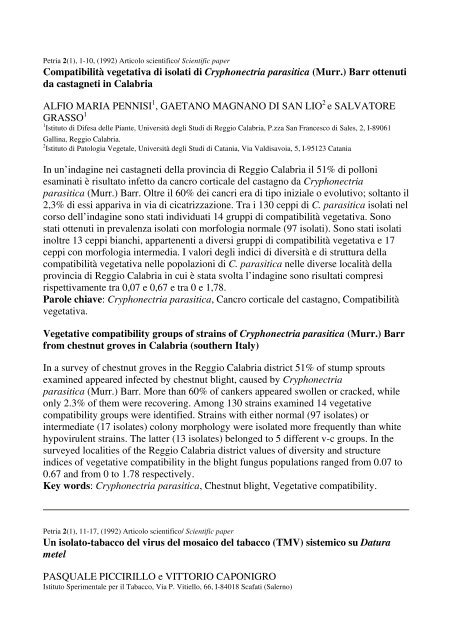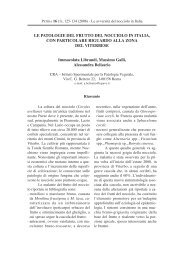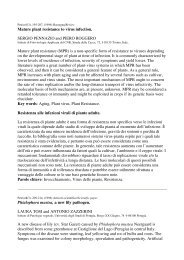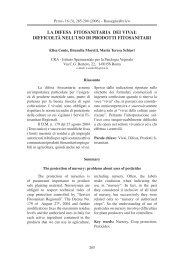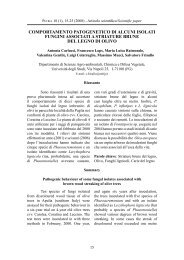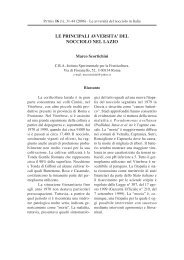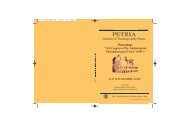Volume/Issue 1 - CRA-PAV
Volume/Issue 1 - CRA-PAV
Volume/Issue 1 - CRA-PAV
You also want an ePaper? Increase the reach of your titles
YUMPU automatically turns print PDFs into web optimized ePapers that Google loves.
Petria 2(1), 1-10, (1992) Articolo scientifico/ Scientific paper<br />
Compatibilità vegetativa di isolati di Cryphonectria parasitica (Murr.) Barr ottenuti<br />
da castagneti in Calabria<br />
ALFIO MARIA PENNISI 1 , GAETANO MAGNANO DI SAN LIO 2 e SALVATORE<br />
GRASSO 1<br />
1 Istituto di Difesa delle Piante, Università degli Studi di Reggio Calabria, P.zza San Francesco di Sales, 2, I-89061<br />
Gallina, Reggio Calabria.<br />
2 Istituto di Patologia Vegetale, Università degli Studi di Catania, Via Valdisavoia, 5, I-95123 Catania<br />
In un’indagine nei castagneti della provincia di Reggio Calabria il 51% di polloni<br />
esaminati è risultato infetto da cancro corticale del castagno da Cryphonectria<br />
parasitica (Murr.) Barr. Oltre il 60% dei cancri era di tipo iniziale o evolutivo; soltanto il<br />
2,3% di essi appariva in via di cicatrizzazione. Tra i 130 ceppi di C. parasitica isolati nel<br />
corso dell’indagine sono stati individuati 14 gruppi di compatibilità vegetativa. Sono<br />
stati ottenuti in prevalenza isolati con morfologia normale (97 isolati). Sono stati isolati<br />
inoltre 13 ceppi bianchi, appartenenti a diversi gruppi di compatibilità vegetativa e 17<br />
ceppi con morfologia intermedia. I valori degli indici di diversità e di struttura della<br />
compatibilità vegetativa nelle popolazioni di C. parasitica nelle diverse località della<br />
provincia di Reggio Calabria in cui è stata svolta l’indagine sono risultati compresi<br />
rispettivamente tra 0,07 e 0,67 e tra 0 e 1,78.<br />
Parole chiave: Cryphonectria parasitica, Cancro corticale del castagno, Compatibilità<br />
vegetativa.<br />
Vegetative compatibility groups of strains of Cryphonectria parasitica (Murr.) Barr<br />
from chestnut groves in Calabria (southern Italy)<br />
In a survey of chestnut groves in the Reggio Calabria district 51% of stump sprouts<br />
examined appeared infected by chestnut blight, caused by Cryphonectria<br />
parasitica (Murr.) Barr. More than 60% of cankers appeared swollen or cracked, while<br />
only 2.3% of them were recovering. Among 130 strains examined 14 vegetative<br />
compatibility groups were identified. Strains with either normal (97 isolates) or<br />
intermediate (17 isolates) colony morphology were isolated more frequently than white<br />
hypovirulent strains. The latter (13 isolates) belonged to 5 different v-c groups. In the<br />
surveyed localities of the Reggio Calabria district values of diversity and structure<br />
indices of vegetative compatibility in the blight fungus populations ranged from 0.07 to<br />
0.67 and from 0 to 1.78 respectively.<br />
Key words: Cryphonectria parasitica, Chestnut blight, Vegetative compatibility.<br />
Petria 2(1), 11-17, (1992) Articolo scientifico/ Scientific paper<br />
Un isolato-tabacco del virus del mosaico del tabacco (TMV) sistemico su Datura<br />
metel<br />
PASQUALE PICCIRILLO e VITTORIO CAPONIGRO<br />
Istituto Sperimentale per il Tabacco, Via P. Vitiello, 66, I-84018 Scafati (Salerno)
Un’indagine è stata fatta per verificare la presenza di Tobamovirus in 63 campioni di<br />
piante infette di tabacco. Il TMV "type strain" è risultato presente in 59 campioni, il<br />
ToMV in 4 campioni. Due isolati del TMV "type strain" si sono differenziati dagli altri<br />
per la formazione di mosaico su Datura metel, specie nota per la reazione necrotica<br />
locale al TMV. In questi isolati la risposta delle altre piante test, le proprietà fisiche e<br />
sierologiche sono risultate simili al TMV "type strain". Per la resistenza ai Tobamovirus,<br />
espressa come reazione ipersensibile, (in pomodoro e peperone), sono comparsi nel<br />
tempo nuovi ceppi virali capaci di sistemizzare, mentre non sono stati ancora riscontrati<br />
ceppi di TMV in grado di sistemizzare su genotipi di N. tabacum con il fattore N.<br />
Parole chiave: Tabacco, TMV, Reazione ipersensibile.<br />
A tobacco isolate of tobacco mosaic virus (TMV) systemic on Datura metel<br />
Sixty-three samples of tobacco were tested in glasshouse for Tobamovirus infections.<br />
TMV "type strain" was detected in 59 samples, ToMV in 4 samples. Two TMV "type<br />
strain" isolates were differentiated by Datura metel for causing mosaic on this species,<br />
well known for necrotic local response to TMV. Physical and serological properties of<br />
these isolates were similar to those of TMV "type strain". In tomato and pepper, the<br />
resistance of hypersensitivity type has been frequently overcome by new systemizing<br />
TMV strains, whereas no virus strain has been found to overcome the N type of<br />
resistance in tobacco.<br />
Key words: Tobacco, TMV, Hypersensitivity.<br />
Petria 2(1), 19-27, (1992) Articolo scientifico/ Scientific paper<br />
Evaluation of chemicals against Thielaviopsis basicola on tobacco in vitro and in soil<br />
LAURA TOSI and ANTONIO ZAZZERINI<br />
Istituto di Patologia Vegetale, Università degli Studi di Perugia, Borgo XX Giugno, 74, I-06100 Perugia<br />
Of nine fungicides evaluated in vitro benomyl, thiabendazole, triadimenol and dazomet<br />
inhibited mycelial growth of Thielaviopsis basicola, but only dazomet at 40 and 80 ppm<br />
a.i. was fungitoxic. Fosetyl-Al and metham sodium greatly reduced fungal growth at 40<br />
and 80 ppm ai., whereas iprodione, vinclozolin and tolclofos-methyl were only slightly<br />
effective. The herbicides alachlor, metolachlor, metobromuron and pendimethalin were<br />
more active against the fungus than diphenamid. Several chemicals applied as soil<br />
drenches decreased the inoculum density of T. basicola after 45 days, but only benomyl<br />
and dazomet totally eradicated the pathogen. In greenhouse trials tobacco black root rot<br />
was greatly reduced by benomyl applied as soil drenches after sowing and by<br />
triadimenol (10 and 20 ppm a.i.) applied 15 days before sowing; tolclofos-methyl and<br />
fosetyl-Al, were ineffective. Triadimenol and fosetyl-Al, when applied immediately after<br />
sowing, were phytotoxic. In a second experiment, triadimenol was more active when<br />
applied by soil drench than by root immersion.<br />
Key words: Tobacco, Thielaviopsis basicola, Fungicides, Herbicides.
Valutazione di alcuni fitofarmaci contro Thielaviopsis basicola su tabacco in vitro e<br />
nel terreno.<br />
Di nove fungicidi saggiati in vitro, benomyl, tiabendazolo, triadimenol e dazomet hanno<br />
inibito lo sviluppo di Thielaviopsis basicola e solo dazomet a 40 e 80 ppm di p.a. è<br />
risultato fungitossico. Fosetil-alluminio e metam sodio hanno ridotto notevolmente la<br />
crescita miceliale a 40 e 80 ppm di p.a., mentre iprodione, vinclozolin e tolclofos-metile<br />
sono stati scarsamente attivi. Alaclor, metolaclor, metobromuron e pendimetalin si sono<br />
rivelati più efficaci del difenamide. Vari fitofarmaci, applicati al terreno, hanno<br />
determinato un notevole decremento della densità di inoculo di T. basicola dopo 45<br />
giorni ma solo benomyl e dazomet hanno totalmente eradicato l’inoculo del patogeno. In<br />
prove in serra il benomyl, applicato al terreno dopo la semina del tabacco e il<br />
triadimenol (10 e 20 ppm di p.a.) somministrato 15 giorni prima della semina hanno<br />
ridotto notevolmente il marciume radicale; tolclofos-metile e fosetil-alluminio non sono<br />
stati attivi. Triadimenol e fosetil-alluminio, applicati subito dopo la semina, hanno<br />
manifestato effetti fitotossici. In un secondo esperimento il triadimenol è risultato più<br />
attivo somministrato al terreno che somministrato direttamente alle radici delle piante.<br />
Parole chiave: Tabacco, Thielaviopsis basicola, Fungicidi, Erbicidi.<br />
Petria 2(1), 29-72, (1992)<br />
Sixth Conference on Virus Diseases of Gramineae in Europe<br />
Torino (Villa Gualino), Italy June 18-21, 1991<br />
Organized by:<br />
Istituto di Fitovirologia Applicata, Consiglio Nazionale delle Ricerche, Torino, Italy<br />
Foreword<br />
Members of the family Gramineae supply basic food to about three quarters of the<br />
world’s population but can be affected by several viruses which sometimes reduce their<br />
yield dramatically. The most dangerous world-wide is certainly barley yellow dwarf<br />
virus, a luteovirus transmitted persistently by aphids and causing the ‘yellow plague’ of<br />
cereals; other viruses, such as some transmitted by fungi (furoviruses) or by leafhoppers<br />
(reoviruses, rhabdoviruses) are also economically important. Two examples of these in<br />
Italy are soil-borne wheat mosaic virus, transmitted by Polymyxa graminis, and maize<br />
rough dwarf virus, transmitted propagatively by the planthopper Laodelphax<br />
striatellus.Another important group of Gramineae-infecting viruses includes maize<br />
dwarf mosaic virus, sugarcane mosaic virus A and B, and other potyviruses which are<br />
transmitted non-persistently by aphids and occur worldwide. Problems concerning the<br />
identification, taxonomy, epidemiology and control of viruses of Gramineae were<br />
discussed in Turin, Italy, during the ‘Sixth Conference on Virus Diseases<br />
of Gramineae in Europe’ (Villa Gualino, 18-21 June 1991). This was organized by the<br />
Istituto di Fitovirologia Applicata of the Consiglio Nazionale delle Ricerche, Turin,
following a decision made in Budapest by the European Working Group<br />
on Gramineae Viruses (EWGGV) at the end of the previous Conference. The Group was<br />
established about twenty years ago on the initiative of plant virologists from France,<br />
Germany, Italy, Yugoslavia, Sweden and the U.K. and now includes about fifty<br />
members from different countries. Its purpose is to encourage the co-operation and<br />
exchange of information on research on Gramineae viruses between the members of the<br />
Group. To this aim, meetings of the Group are organized periodically such as those held<br />
in Belgrade (1974), Montpellier (1977), Rothamsted (1980), Braunschweig (1985) and<br />
Budapest (1988). The Sixth Conference of Turin was sponsored by the Italian Ministry<br />
of Agriculture and Forestry, the Region of Piedmont, the Province and Town of Turin,<br />
the Consiglio Nazionale delle Ricerche – whose financial contributions are aknowledged<br />
gratefully – the Italian Association of Plant Pathologists and the Academy of Agriculture<br />
of Turin. The Scientific Committee of the Conference included M. Conti, G.P. Martelli,<br />
A. Matta, R.G. Milne, A. Quacquarelli and E. Refatti, while the Organizing Commettee<br />
included A. Appiano, G. Boccardo, P. Caciagli, M. Conti and V. Lisa. The Conference<br />
was attended by scientists from eighteen different countries, including some extra-<br />
European for the first time which indicates the increasing interest of the Group’s field<br />
world-wide. The Conference included six Sessions, namely:<br />
1. Diagnosis and characterization of Gramineae viruses;<br />
2. Epidemiology and control of Gramineae viruses;<br />
3. Epidemiology and control of barley yellow dwarf virus;<br />
4. Diagnosis and characterization of barley yellow dwarf virus;<br />
5. Soil-borne viruses;<br />
6. Maize viruses.<br />
Each Session was introduced by an opening paper given by an invited speaker, and was<br />
followed by offered papers. Altogether, forty-six papers were presented, and the<br />
abstracts are collected in this Journal.<br />
Maurizio Conti<br />
Presentazione<br />
Varie specie della Famiglia Graminaceae costituiscono nel loro insieme la base<br />
alimentare di circa tre quarti della popolazione mondiale e possono essere infettate da<br />
diversi virus che ne riducono drasticamente la produzione. Il più dannoso di questi in<br />
tutte le regioni cerealicole è certamente barley yellow dwarf, un luteovirus trasmesso da<br />
afidi in modo persistente, agente della cosiddetta ‘peste gialla’ dei cereali; diversi altri<br />
virus, come alcuni trasmessi da funghi (furovirus) o da cicaline (reovirus, rhabdovirus)<br />
sono pure di rilevante importanza economica. Due esempi di questi, per l’Italia, sono<br />
soil-borne wheat mosaic virus, trasmesso daPolymyxa graminis, e maize rough dwarf<br />
virus, trasmesso con modalità propagative dalla cicalina Laodelphax striatellus. Un<br />
altro importante gruppo di virus delle graminacee include maize dwarf mosaic,<br />
sugarcane mosaic virus A e B ed altri potyvirus trasmessi da afidi in modo nonpersistente<br />
e diffusi in tutto il mondo. I problemi relativi a identificazione, tassonomia,<br />
epidemiologia e lotta dei virus delle graminacee sono stati discussi a Torino nel corso<br />
della "IV Conferenza sulle virosi delle Graminacee in Europa" (Villa Gualino, 18-21
giugno 1991). Essa è stata organizzata dall’Istituto di Fitovirologia Applicata del<br />
Consiglio Nazionale delle Ricerche di Torino e in seguito ad accordi definiti a Budapest<br />
nell’ambito del Gruppo Europeo di Lavoro sui Virus delle Graminacee (EWGGV), in<br />
conclusione della precedente Conferenza. Questo Gruppo, fondato circa vent'anni<br />
orsono per iniziativa di virologi vegetali in Francia, Germania, Italia, Jugoslavia,<br />
Svezia e Gran Bretagna, include oggi circa cinquanta membri di Paesi diversi. Sua<br />
principale finalità è la promozione di collaborazioni e scambi di informazione e<br />
materiale di studio tra i membri, in tema di virus delle graminacee. A tal fine sono<br />
organizzati periodicamente convegni che hanno avuto luogo in passato a Belgrado<br />
(1974), Montpellier (1977), Rothamsted (1980), Braunschweig (1985) e Budapest<br />
(1988). La Sesta Conferenza di Torino ha avuto il patrocinio del Ministero<br />
dell’Agricoltura e delle Foreste, della Regione Piemonte, della Provincia, del Comune<br />
di Torino, del Consiglio Nazionale delle Ricerche – che si ringraziano per il contributo<br />
finanziario – della Associazione Fitopatologica Italiana e della Accademia di<br />
Agricoltura di Torino. Il Comitato scientifico della Conferenza è stato formato da M.<br />
Conti, G.P. Martelli, A. Matta, R.G. Milne, A. Quacquarelli ed E. Refatti mentre il<br />
Comitato organizzatore ha contato su A. Appiano, G. Boccardo, P. Caciagli, M. Conti e<br />
V. Lisa. Alla Conferenza hanno partecipato ricercatori di diciotto Paesi, inclusi alcuni<br />
extra-europei – per la prima volta nella storia del Gruppo – a testimonianza del<br />
crescente interesse per l’argomento in tutto il mondo. La Conferenza si è articolata in<br />
sei Sessioni, precisamente:<br />
1. Diagnosi e caratterizzazione dei virus delle graminacee;<br />
2. Epidemiologia e lotta dei virus delle graminacee;<br />
3. Epidemiologia e lotta di barley yellow dwarf virus;<br />
4. Diagnosi e caratterizzazione di barley yellow dwarf virus;<br />
5. Virus trasmessi nel terreno;<br />
6. Virus del mais.<br />
Ogni Sessione è stata aperta da una relazione generale predisposta su invito, seguita da<br />
comunicazioni libere. Nel complesso sono stati presentati quarantasei lavori scientifici i<br />
cui riassunti sono raccolti in questa Rivista.<br />
Maurizio Conti<br />
Presented papers/ Lavori<br />
presentati Page/pagina<br />
PAUL H.L. Diagnosis and characterization, some reflections. 33<br />
MULLINEAUX Ph.M., . HOFER J.M.I, ACCOTTO G.P. Transcription and<br />
DNA replication in cereal-infecting geminiviruses for producing host<br />
resistance.<br />
SHUKLA D.D., McKERN N.M., FRENKEL M.J., JILKA J. Immunological<br />
and molecular approaches to identification and classification of potyvirus<br />
33<br />
35
infection in maize, sorghum and sugarcane.<br />
GNUTOVA R.V.,SIBIRYAKOVA I.I., SAPOTSKY M.V., KAKAREKA<br />
N.N., MOISEENKO L.I. Immunodiagnostics of cereal viruses in the Far<br />
East.<br />
FUCHS E., PROESELER G., OTTO F., HERRMANN G. Diagnosis of<br />
SCMV, MDMV, BYDV, BaYMV and BaMMV using dot immunobinding<br />
assay.<br />
STEIN-MARGOLINA Vita A. Electron microscopy of cereals infected with<br />
viruses.<br />
GUGLIELMONE L., CACIAGLI P., MAGGIORE T., FOGLIANI G. Etiology<br />
and epidemiology of a disease of seed maize in northern Italy (Cremona<br />
province).<br />
OSLER R., LOI N., REFATTI E., LORENZONI C., SNIDARO M.. On the<br />
influence of barley yellow dwarf virus and maize dwarf mosaic virus, singly<br />
or doubly infecting the B73 maize inbred line.<br />
BORODINA E.E., KOSTIN V.D. Characteristics of a potyvirus<br />
from Elytrigia repens.<br />
THRESH J.M.. A comparative approach to the epidemiology of viruses<br />
of Gramineae.<br />
HELENIUS J., PELTONEN-SAINIO P., KARVONEN T. Testing of a<br />
simulation model for estimating yield reduction of oats resulting from<br />
barley yellow dwarf virus (BYDV) infection.<br />
POCSAI E., MURÁNYI I, KOBZA S. Epidemiological occurrence of wheat<br />
dwarf virus on barley breeding materials in Hungary.<br />
HOLMES S.J., MASTERMAN A.J., FOSTER G.N., BELL A.,MILLS<br />
P. Strategic monitoring: a crop-based approach to identifying BYDV high<br />
risk.<br />
LINDSTEN K. Wheat dwarf virus – host range and control. 45<br />
MAMAEV P.Yu. Comparison of cereal mosaic virus with rhabdoviruses<br />
from China and Japan.<br />
TOŠIC M., MIJAVEC A.. Resistance of some sorghum genotypes to MDMV. 47<br />
MIJAVEC A., TOSIC M., BERENJI J. Breeding of Broomcorn for resistance<br />
to MDMV.<br />
CACIAGLI P., GUGLIELMONE L., MINELLI L., ODASSO M.. Testing<br />
maize hybrids for susceptibility to maize rough dwarf virus(a).<br />
PLUMB R.T. Epidemiology and control of BYDV. 50<br />
KARJALAINEN R., PELTONEN-SAINIO P. Disease development of barley<br />
yellow dwarf virus (BYDV) on oat cultivar mixtures.<br />
JASNIC S., BOSKOVIC M., FALAK I., BOSKOVIC J. Occurence of barley<br />
yellow dwarf virus (BYDV) in Yugoslavia and the future research<br />
program.<br />
36<br />
37<br />
38<br />
39<br />
40<br />
41<br />
41<br />
43<br />
44<br />
45<br />
46<br />
48<br />
49<br />
51<br />
51
PELTONEN-SAINIO P., KARJALAINEN R. Barley yellow dwarf virus<br />
(BYDV) as a limiting factor of oat production in Finland.<br />
MEZZALAMA M., RANIERI R., BURNETT P.A. Annual variation in<br />
serotypes of barley yellow dwarf viruses in cereals, in the Toluca valley of<br />
Mexico.<br />
COMAS J., PONS X., ALBAJES R., PLUMB R.T. Maize in barley yellow<br />
dwarf virus (BYDV) epidemiology in Northeast Spain.<br />
BURNETT P.A., RANIERI R., MEZZALAMA M..The effect of barley yellow<br />
dwarf viruses on the yield of wheat in Mexico.<br />
HUTH W., ZÜCHNER S. Behaviour of Lolium perenne to inoculations of<br />
barley yellow dwarf virus (BYDV).<br />
BURNETT P.A.. Diagnosis and characterizazion of barley yellow dwarf<br />
viruses.<br />
RANIERI R., BURNETT P.A. Titre of barley yellow dwarf viruses in spring<br />
barleys.<br />
FAVALI M.A., MUSETTI R., OSLER R., LOI N. Comparative study on<br />
barley yellow dwarf virus infections in maize and oat plants.<br />
BIANCHI G.L., COCEANO P.G., PERESSINI S. Application of ELISA to<br />
maize infected with barley yellow dwarf virus.<br />
GOLETTI T., DE PACE C., PORCEDDU E., SCARASCIA MUGNOZZA<br />
G.T., LOI N., OSLER R. Response of a wide range of Triticeae species to<br />
controlled barley yellow dwarf virus (BYDV) infection.<br />
TOSIC M., BALAZ F. Barley yellow dwarf virus present in Yugoslavia. 60<br />
GILMER D., SCHMITT C., JUPIN I., JONARD G., GUILLEY H.,<br />
RICHARDS K. Infectious transcripts of beet necrotic yellow vein virus and<br />
their use in investigating viral pathogenesis.<br />
JIANPING C., ADAMS M.J., PLUMBR.T. Barley mild mosaic virus<br />
detection inside Polymyxa graminis.<br />
KUMMERT J., CHANDELIER A. Situation of barley yellow mosaic disease<br />
in Belgium in 1990–1991.<br />
RUBIES-AUTONELL C., VALLEGA V. Reactions of diploid<br />
wheat, Triticum monococcum, to soil-borne wheat mosaic virus and wheat<br />
spindle streak mosaic virus.<br />
GÖTZ R., ORDON F., HUTH W., FRIEDT W. Genetic diversity of resistance<br />
to the "barley yellow mosaic virus complex".<br />
KRSTIC B., TOSIC M.. Contribution to the study of the potyviruses<br />
infecting maize in Yugoslavia.<br />
ACHON A., MEDINA V. Potyvirus infecting maize in Catalonia (Spain). 66<br />
KOVACS Gy., MILINKO I., GYULAVARY O., HOANG N.D.,<br />
GABORJANYI R. Damage caused by potyvirus infection in maize seed<br />
production.<br />
52<br />
53<br />
54<br />
55<br />
55<br />
56<br />
57<br />
58<br />
59<br />
60<br />
61<br />
62<br />
63<br />
64<br />
65<br />
66<br />
67
BALAZ F., TOSIC M.. Barley yellow dwarf virus, a new and important<br />
pathogen of maize in Yugoslavia.<br />
APPIANO A., CACIAGLI P., ADRIAN M.. Fine structure of maize rough<br />
dwarf virus.<br />
MARZACHÌ C., BOCCARDO G. Characterization of two genomic segments<br />
of maize rough dwarf virus, a plant infecting reovirus.<br />
LECLERCQ-LE QUILLEC F., DEDRYVER C.A , TANGUY S. Dynamics of<br />
BYDV strains and their vectors in Brittany from 1989 to 1991.<br />
BEUVE M., LAPIERRE H. Susceptibility to BYDV-<strong>PAV</strong> and to BYD-RPV<br />
in the genus Bromus.<br />
68<br />
69<br />
70<br />
70<br />
72


